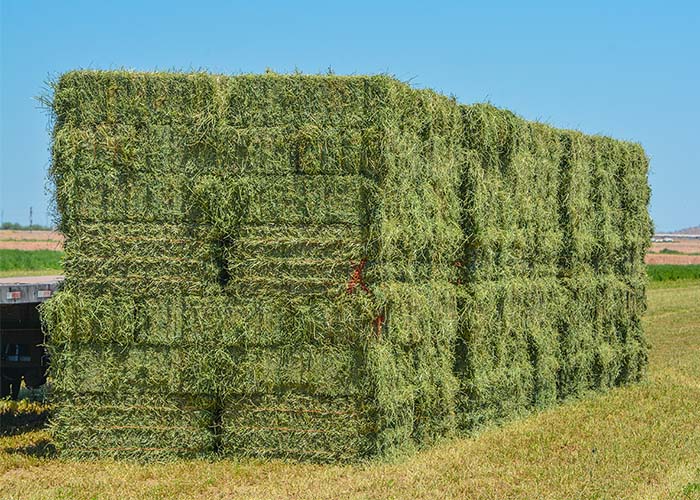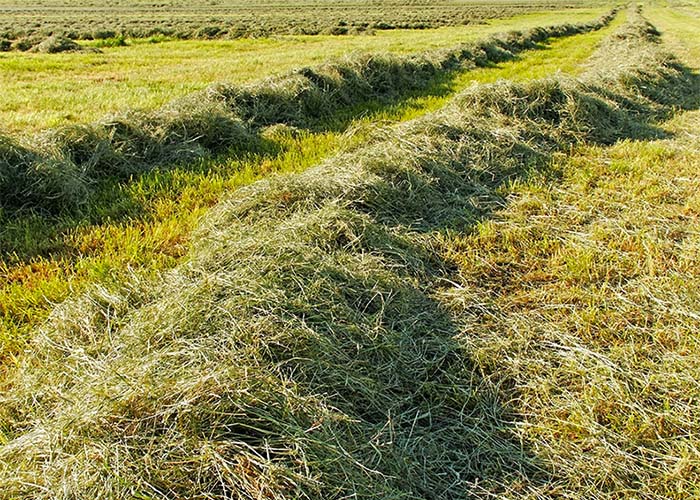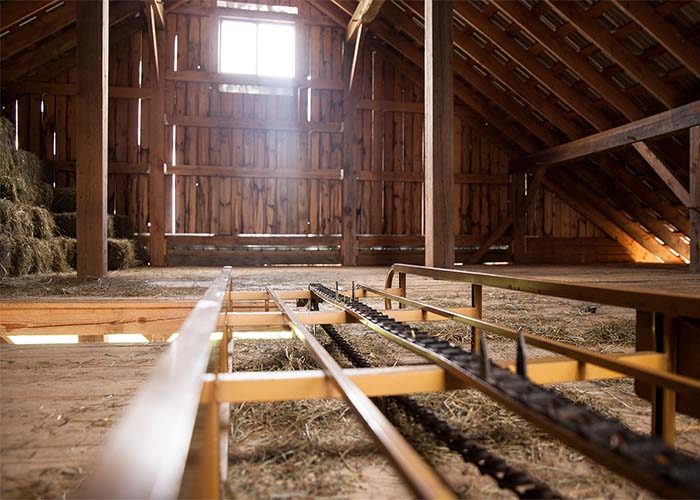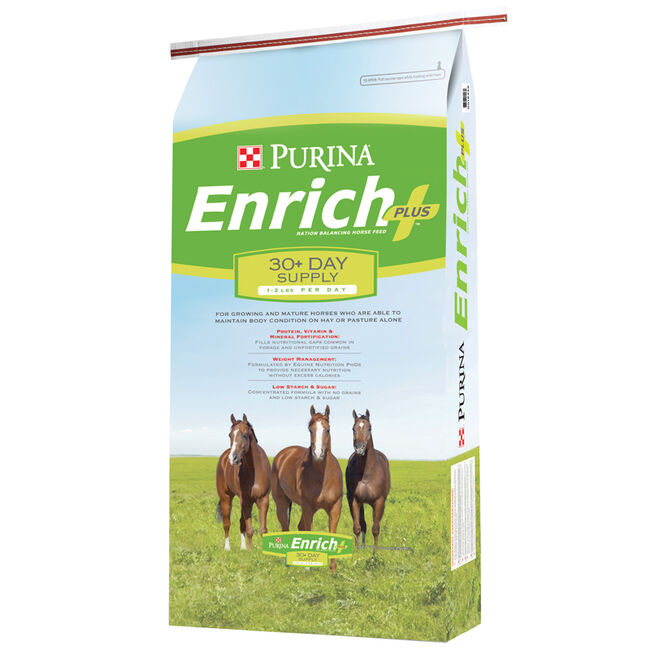
As grazing animals, hay or forage plays a large role in a horse’s diet. In the wild, horses received the vast majority of their nutritional requirements from grasses and hays. Today many domestic horses eat grain and supplements in conjunction with their forage, but hay/forage is number one. Horses should eat the majority of their calories from forage sources, whether that be pasture in the summer or hay in the winter months.
Forage should be considered a horse’s main source of nutrients since it contains most of the calories that they need to thrive. Choosing the right hay for your horse is an essential part of your horse’s overall wellness. Join us as we explore the hallmarks of quality hay and forage and how to store your hay after you have made your purchase.
What is Hay?
Hay is dried grass or legume stalks that have typically been cut and dried in the field prior to being baled. Drying the grass preserves the harvest and allows it to be fed to horses and livestock throughout the winter months. Generally, the hay is cut in the late spring and summer months with a mower on a tractor and then spread to allow the sun to dry the hay. After a day or two of drying the hay is turned over with an apparatus known as a “tedder”, this fluffs and circulates the drying hay to ensure that it is equally dry. Once the hay is dry enough to bale, the hay farmer returns to the field with a rake attachment on the tractor to gather the hay into rows, this makes the baling process easy. Finally, a baler is run through the field, collecting the hay and compressing it into bales. You can watch a video of this incredible process here:
Types of Hay
Hay can be made from a variety of grasses and legumes. The type of grass that you choose will have a large impact on the nutritional value of the hay. Generally, hay is broken down into four different classes: grass, legume, mixed (grass and legume), and cereal grains.
Grass Hay
Hays made from grasses, such as timothy and orchard grass, are the most common types of hay in the Northeast. These hays are high in fiber and contain balanced proteins, making them appropriate for nearly every horse. The fiber content keeps the digestive tract moving, helping to reduce upsets such as colic.
In the northeast, cool-weather grasses are the popular hays. Typically orchard grass is higher in protein and caloric count than timothy hay. For horses who are prone to laminitis or are overweight, timothy hay is an excellent choice. Timothy is extremely palatable and tends to be quite soft, which makes it easy for foals or horses with dental issues to eat. In other climates, warm-weather grasses, like bromegrass, coastal grass, and teff hay are often fed. When given the choice, many horses prefer the taste of cool-climate grasses.
Legume Hay
Legume hay, such as alfalfa hay, red clover hay, and white clover hay, tends to be a nutritional powerhouse while being highly palatable. It contains high levels of protein, as well as many vitamins and minerals yet is low in starches and sugars; it also has a higher level of digestible energy than grass hay.
Depending on your horse’s needs, legume hay may be too rich for your horse, while other horses thrive on alfalfa hay. Many high-performance horses eat legume hay as a way to promote muscle growth and keep weight on during a busy competition season. If you have an underweight horse, consider adding alfalfa to their diet because it has more calories and will help them to gain condition with its high protein content. Generally, alfalfa hay is not recommended for overweight horses but can safely be fed to insulin resistant horses in small amounts because of its low sugar/starch profile.. It also costs more than traditional grass hays. Alfalfa is predominantly grown in the northern part of the United States where it is a popular crop both in the Northeast and Northwest.
Mixed Hay (Grass and Legume)
The ideal hay for many horses, mixed hays are a blend of grasses and legumes. Many times they come in equal proportions, although every hayfield and hay farmer may have their own blend. These combination formulas combine the benefits of legume hay, with the lower price tag of grass hay. It also prevents horses from getting overly energetic (or “hot”), which can be seen on pure legume hay. The most popular blend by far is timothy/alfalfa. Also orchard grass/ alfalfa and orchard glass/clover are good choices too.
Cereal Grain Hay
Typically horses are not fed cereal grain hay (such as oat hay, rye hay, and wheat hay), due to the risk of nitrate poisoning. These grains tend to still have the seed heads on the stem when they are harvested, making them much higher in nitrates than grass hays and legume hays. If you must feed cereal hay, they should only be fed in small amounts and under the advice of your veterinarian. Horses who are prone to laminitis or founder should not be fed cereal grains.
Type of Bales
Hay bales can come in a variety of different shapes and sizes. Most horse owners are familiar with small square bales, which weigh about 40-50 pounds, are secured with twine, and are easily broken up into manageable pieces (known as “flakes”). Three-string square bales tend to be a bit larger and weigh in about 100 lbs. Hay can also be purchased in compressed bales, also known as high-density bales, which are the same size as square bales, but weigh about 120-150lbs, typically alfalfa hay comes in compressed bales. Large square bales are also available and weigh in at 600-1,200 pounds; these can be difficult to move but still provide quality hay. Hay is also available in round bales, these are also heavy (500+ pounds) but can be successfully fed in a pasture; when purchasing round bales, it is important to purchase horse-quality round bales.

Determining Hay Quality
There are a number of factors that go into determining the quality of the hay that can be inspected visually. This includes the cut, the maturity of the grass, the condition of the hay, and the presence of foreign matter. When you are first presented with a new batch of hay, take a closer look! Using your observation powers, you can ascertain a great amount of information about the hay. Horses should never be fed cow hay, silage, or mulch hay because these will react adversely to their sensitive digestive systems and can cause fatalities. Cow hay and silage are fermented, which horse’s stomachs cannot digest; feeding cow hay or silage will cause your horse to colic. Mulch hay is typically labeled as such because it is poor quality hay, may contain species that horses should not eat (like straw), and may be moldy; all of which is extremely detrimental to your horse’s health.
Maturity
“The stage of maturity at harvest plays a major role in determining the quality of a forage,” explains Carl Majewski, a Dairy, Livestock, and Forage Crops Field Specialist at the New Hampshire Cooperative Extension at the University of New Hampshire. “Early in the growing season, forage plants move into their vegetative stage, characterized by leafy growth containing high concentrations of starches, sugars, proteins, and minerals. As the growing season progresses, plants enter the reproductive stages, characterized by elongated stems and developing seed heads. The dry matter in these mature plants has a lower proportion of nutrients and a higher proportion of plant fiber. The greater the fiber content of hay, the less digestible it is, and the less an animal will consume before it fills its stomach. Therefore, the best hays contain a high proportion of leaves and few seed heads or stems.”
When shopping for hay, look for younger grasses with soft stems and not very many seeds. Not only will your horse find this hay more delicious and easier to eat, but it will also carry a higher nutritional value.
Cut
Generally, hay is sold as first-cutting, second-cutting, or even third-cutting (typically not available in temperate climates like the Northeast due to the shortened growing season). This describes the chronological order of when the hay has been cut during that season.
Typically, first cutting hay is lower in nutrients than second cutting hay, it also tends to be coarser and tougher. This is because the harsh spring growing conditions lead to thicker stems and stalks. First cutting hay can also have more weeds than proceeding cuts. Some people prefer first-cutting horses for overweight horses because they can still eat large amounts of forage to keep their digestive systems moving without gaining additional weight.
Second-cutting hay is prized because it tends to be softer and easier to eat. It is also greener in color and leafier than first cutting hay. Because of the higher proportion of leaves, it tends to be denser and have more protein. Many performance horses are fed second-cutting hay due to the higher nutritional value. Senior horses also thrive on second-cutting hay because of the soft texture.
Third-cutting hay, if it is available to you, is very lush and thick. Many horses love the soft, leafy texture of this hay. If you have a horse with metabolic issues or a horse who is overweight, it should be fed with caution, due to its richness and high nutritional value.

Condition of Hay
“Hay quality will also depend on how the hay was harvested, handled, and stored,” Carl says. “Ideally, to preserve nutrients, hay should cure in dry, sunny weather as quickly as possible. Once it’s at the proper moisture content (15 %-18%), it should be taken from the field and stored in a dry, well-ventilated area. Hay not harvested and stored under these conditions may lose nutrients or get moldy, both of which dramatically lower quality.”
The best way to confirm the condition of hay is to pick up a flake of hay and investigate it. Thoroughly smell the hay, it should smell sweet and fresh, and should never have any moldy aromas. Give the hay a good shake to determine whether the hay is dusty (this is particularly important if you have a horse that suffers from heaves or another respiratory ailment). Then, take a closer look at the color of the hay, good quality hay will be light green in color (alfalfa hay will be a deep green), while lower-quality hay will appear brown and bleached in color. Sometimes, the outer edges of the bale will be slightly brown, but the interior is still green; this is still appropriate to feed to your horse. A bale of hay should not be exceedingly heavy or heavier than usual, since this signifies that the hay may not be thoroughly dried.
Foreign Matter
When visually assessing the hay, it is important to determine that the hay is all grasses and/or legumes. Take a long look at the flakes to ensure that the hay is free from sticks, rocks, and trash that may have blown into the field prior to haying. You should also look for potentially poisonous plants and weeds. It is also a good idea to look for poison ivy in the hay– this will not cause your horses any adverse reactions, but it can cause severe allergic reactions to the humans who are feeding out the hay.
“High-quality hay comes from healthy forage stands with few or no weeds. Hay balers occasionally pick up stray foreign objects, such as trash or broken machinery parts. These pose a real threat to animal health, so high-quality hay must be free of foreign material,” explains Carl.
Hay Testing

One piece of the hay quality puzzle that can not be verified visually is the nutritional content of the hay. The best way to ascertain the nutritional values is to have a laboratory forage test performed. To test your hay, you will need to send off a sample or a core to a third-party testing facility, such as Equi-Analytical or Weld Laboratories. Many grain companies, including Nutrena, Buckeye Nutrition, and others, also provide hay testing programs so that you can integrate their grain into your feeding programs properly. Many commercial forage products such as Lucerne Farms Forage and Standlee Forage have already been tested so that you can properly analyze what your horse is consuming. You can learn more about the reasons that many equestrians feed chopped forage on our blog post, Discover the Benefits of Chopped Forage.
When you send your hay in for forage testing, they will provide you with a detailed analysis of the nutritional components of the hay. A completed hay analysis will identify the following values:
- Dry Matter: The percentage of your forage that is not water.
- Moisture: The relative water content of your forage.
- Crude Protein (CP): The amount of total plant protein in the hay.
- Digestible Energy (DE): The amount of energy your horse can receive from the hay (similar to the caloric count).
- Non-Structural Carbohydrates (NSC): This includes the number of carbohydrates, other than fiber, in the hay. This is an important number, particularly if your horse has metabolic diseases or insulin resistance and therefore needs to limit their sugar intake. The NSC includes the total amount of starch, water-soluble carbohydrates (WSC), and ethanol soluble carbohydrates (ESC).
- Relative Feed Value (RFV) – While not included in all hay analyses, this refers to the overall quality of the hay. The higher the score, the higher the quality of the hay.
When you receive your finalized hay analysis, it will report back to you with a large amount of information, an associate from your local feed store or your feed rep will be able to help you decode the information and determine the proper concentrate (grain) or forage balancer to pair with this forage, while also formulating additional feeding recommendations. A forage analysis is very important if you have a horse that needs to limit its NSC intakes, such as horses prone to laminitis or founder.
Forage Balancers
In recent years, all-forage or forage-first diets have become increasingly popular among many horse owners. This is in an effort to return horses to a more natural way of feeding without the addition of carbohydrates and sugars from grains. However, frequently forage is unable to provide your horse with all of the essential nutrients that they need to thrive.
Forage balancers, also known as ration balancers, are concentrated nutrients that help to fill any nutritional gaps when fed alongside a high forage diet. There are a number of formulations available, each of which is generally created to pair with grass hays, legume hays, or mixed hays. You only need to feed a small amount (typically one-two pounds per day). Forage balancers are typically pelleted feeds and can be purchased from your local feed/farm supply store in 30- to 50-pound grain bags. Your hay analysis will help you determine the best ration balancer to pair with your hay based on the nutritional gaps in the profile; for example, hays grown in the northeast will need to be supplemented with selenium, because this is missing from the soil in this area.
Purina Enrich Plus Ration Balancing Feed
This concentrated ration-balancing pelleted horse feed is designed to be fed as a horse’s sole ration, along with quality hay or pasture to provide the proper balance of protein, vitamins, and minerals without unnecessary calories.
Questions to Ask When Purchasing Hay
There are a number of ways that you can purchase hay. Many equestrians purchase it directly from the farmer’s field, while others purchase it on an “as-needed” basis from their farm supply/feed store. Other larger operations may ship in bulk loads of hay on a tractor-trailer truck to meet their needs. Regardless of where you purchase your hay, here are some questions you may want to consider asking:
- Where did this hay come from?
- What cutting is this batch of hay?
- Was the hay rained on prior to or after baling?
- What type of grass or legume is in this hay?
- When was this hay baled?
- Do you fertilize your fields? (Verify they use an equine-safe product)
- Will the supplier replace the hay if it goes bad shortly after purchase?
- What is the price per ton?
- How much does each bale weigh?
- Would it be possible to get a sample bale to determine palatability?
Asking these questions ahead of time will help you make an informed decision about your purchase.
How Much Forage Should I Purchase?
Make sure that you purchase adequate amounts of hay to get you through the winter season. Many suppliers run out of hay, so it is important to shop early and plan in advance. Additionally, hay tends to be less expensive when it is being purchased during the summer out of the field, versus in the winter out of a barn or hay storage facility. Calculate the number of bales that you feed per day and then calculate how much you will need until the next year.
Horses need to eat 1.5-2% of their body weight in hay each day, this means that generally speaking, you can plan on half a bale (20-25 lb) of hay, per 1000 lb. horse, per day. However, this number can vary greatly depending on your horse’s age, workload, weight, and other factors. Be sure to purchase extra for cold weather, because you may need to feel additional hay to maintain your horse’s body condition and need to account for storage and feeding wastage as well.
To estimate your winter hay needs, we recommend using the following calculator equation to determine your total hay needs for each horse. These equations can easily be modified depending on the number of horses you own and the number of times per year that you purchase hay.
First, you need to determine how much hay you need each day, per horse:
Horse’s Body Weight (For example, 1000 lb) X 2% = Daily Forage Needs (20 lb for our example)
Then you can determine your total amount of hay needed for the winter months, for our example, we will use November 1- March 31 (152 days).
Daily Forage Needs (20 lb) X Number of Days (152 days) = Amount of Hay (3040 lb)
Now, you need to account for wastage. Generally, a 5% rate of waste is a good rule of thumb.
Amount of Hay (3040 lb) X Wastage (1.05) = Total Amount of Hay (3192 lb)
Finally, you can divide the Total Amount of Hay by the weight of your hay bales to determine the number of bales that you will need.
Total Amount of Hay (3192 lb) / Average Bale Weight (40 lb) = Number of Bales (About 80 Bales)
This will give you the total number of bales that you need in order to get through the winter months. Whenever possible, you will want to order a few extra bales to cushion your purchase and ensure you have enough to get through until spring.

Storing your Forage
After you have purchased your hay, it is important to store it correctly. Improper storage can lead to a loss of nutritional value or can lead to the hay being completely inedible, for instance, if the hay became moldy or exceptionally dusty. Additionally, if hay is not stored properly, it can overheat and even combust, which can lead to potential disasters such as barn fires. The area should be well ventilated.
Hay should be stored in a dry location out of direct sunlight. Excess sunlight will cause the nutrients in the hay to leach out of the hay. Ideally, the space will be a cool location away from the horses to minimize dust or risk of fire, but many New England barns utilize a hayloft without any ill effects. Haylofts make efficient use of the rafter space above the barn and can also make the hay easy to feed (many barns are equipped with hay drops directly into each stall). However, they can also make the barn dustier and increase the risk of fire from the hay.
To minimize molding and maximize airflow, hay should be stored on wooden pallets. Hay and other forage products should never be stored on concrete or dirt because the excess moisture of these surfaces will cause the hay to mold. Stack the hay will small gaps between each bale to keep the air circulating. The first layer of hay should be stored with the cut side down and the strings running along the sides of the bale. This will not only prevent pesky mice from nibbling at the bale strings; it also allows the excess moisture to run down the stalks and not pool up in the bale. As you continue stacking, alternate the positioning of the bales, with every other row having the strings of the bale on top. If you are stacking hay that is slightly damp, consider sprinkling a small amount of salt between each layer of bales to help draw out the moisture.
Properly stored hay can be fed as much as two-three years after it has been harvested, however, it is important to note that the hay begins losing nutritional content as soon as it is cut. Feeding younger hay will give your horse more nutrients. Even with proper storage, hay may become a bit dusty– this is ok, simply soak the hay in water prior to feeding. Never feed hay that has been rained on heavily, even though mold may not be visible to the naked eye, the potential of mold spores is too great a risk. If your hay has been rained on slightly, spread it out to allow it to dry completely and then feed promptly.
The majority of equine diets contain a high amount of forage in order to keep your horse in optimal health. As you have learned, there is a wide range of hay options and quality available and with proper planning and storage, the right hay will serve you and your horse well. By taking the time to choose the best hay for your horse, you can be confident that you are providing them with the nutrition that they need to thrive.
Do you have questions about the hay you are feeding and how it fits into your horse’s diet? Our experienced and highly trained sales staff is always available to answer your questions. We also have appointments available for complimentary nutrition consultations to help you select the right grain and supplements for your horse based on your forage analysis.

